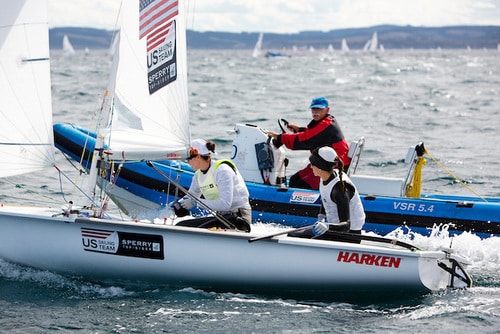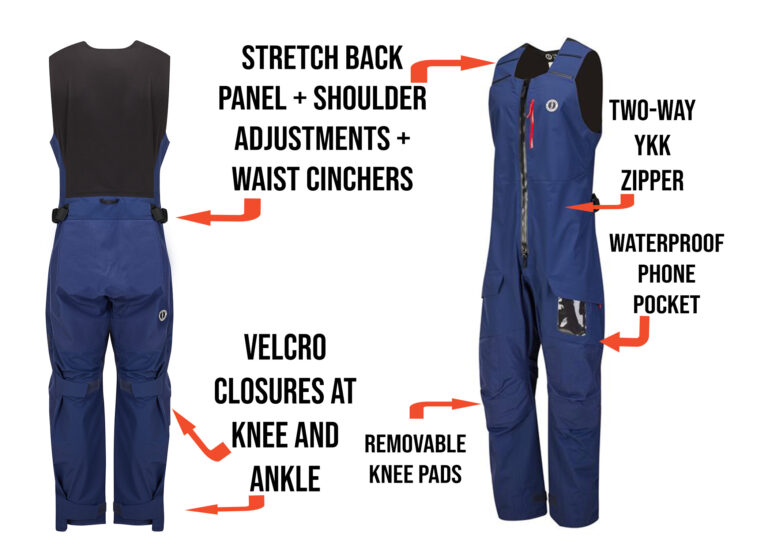For the past two years, sailing legend Dave Ullman has been coaching U.S. women’s 470 sailors Annie Haeger and Briana Provancha. As a team, the arc of their success has been remarkable, culminating this past August with a gold medal in the final Olympic test event in Rio. A big part of their success lies in their ability to navigate the challenges of sailing a two-person boat, where each person’s moves must be carefully choreographed and coordinated with the other. On this stage, success is no accident.
I was fortunate to have teamed up with Tom Linskey for eight years in the 470. Tom was an amazing talent and could easily have been an Olympic-caliber driver, except he wasn’t quite the right size. As a crew, he was perfect, and together we won three 470 world championships. I had total faith in his ability to handle tactics, which allowed me to focus on making the boat go fast. For us, it was an ideal skipper-crew pairing, so whenever I’m coaching two-person boats, I tend to look at it through the lens of my experiences with Tom. Other skipper-crew combinations of experience and ability can be equally successful, but this is one that definitely works. As a coach for a two-person team, I am tasked with discovering the exact division of responsibilities that will produce the greatest strengths in the total racing effort.
In general, when sailing upwind, the skipper is in charge of boatspeed, with the crew playing a mechanical role in that part, mainly handling the jib. The skipper also deals with boat-to-boat tactics. The crew is normally in charge of big-picture tactics as well as keeping tabs on the compass—headers and lifts—and velocity changes. For instance, let’s say you’re sailing on port tack approaching a group of starboard tackers. The crew tells the skipper what they should do—either go behind the group and set up on the group’s weather hip or tack ahead and to leeward of the group and lead them to a header or area of better velocity. The skipper then figures out where to place the boat to make it happen.
Having said that, you must be honest about what each person can do best and then structure the duties around that, setting up roles that build on each person’s strengths. Some skippers prefer to deal with big and small tactics, while the crew concentrates on wind velocity and the compass. It depends on what best fits their personalities and experience. Once the roles are clear, the next goal is to make each person’s job second nature so they do not have to think about what they’re doing. If the skipper is doing all of the tactics, he or she must be able to look around and not have to focus on driving the boat. At the Olympic level, you need to be able to sail at 95% efficiency without even looking at the boat. That means your eyes are not on the sails, where the boom is or anything like that. Instead, your senses tell you how the boat is going. If you don’t have to concentrate on physically sailing the boat, you can concentrate on the chess game that is happening around you.
Downwind, the roles are clear and fixed, because flying the spinnaker is a full-time job for the crew. A good downwind crew never knows where they are on the course. They might be able to spare a glance every two minutes or so to see where the other boats are, but in between those, they shouldn’t have any idea what’s going on and must have total faith in the skipper’s ability to put the boat in the proper place. While the crew deals with the spinnaker, the skipper becomes the eyes of the boat, watching the compass for shifts and keeping an eye out for velocity changes.
What’s the onboard conversation like for a world-class team like Annie and Briana? Annie might tell Bri, “We’re going to go into a low mode,” and Bri might respond, “Ok. We have good pressure, you can work down if you want.” Or for tactical reasons, such as keeping their air clean, Annie might say, “We have to sail slightly higher and faster.” Annie is also watching the compass, and might say, “We’re lifted 10 degrees; next move will be a jibe.” And Bri would simply respond, “Ready to jibe.” In many cases, you might also hear the crew talking about pressure, saying, “I have good pressure,” or “I need more pressure.” That dialogue should be continuous, all the way down the leg.
In the 470 class, when the pumping flag is up, all restrictions on pumping and rocking are lifted, and then the skipper and crew will work to pump and rock the boat in unison. Good teams, such as Annie and Bri, do that with no real discussion. The only thing you might hear is the skipper saying, “This is all working well. We’re gaining,” or “Let’s smooth it out a little; we’re losing.” Overall, the skipper is giving feedback to the crew about how they are doing relative to the other boats so they can regulate the amount of pumping or rocking.
On the starting line, the crew needs to free the skipper up to concentrate fully on getting off the line properly. You’re usually in close proximity to the other boats, but because the skipper is paying so much attention to boat speed, there’s no time to pay attention to the other boats. So the crew has to tell the skipper how they’re doing relative to the boat to windward and the boat to leeward. You usually won’t hear the skipper talking. Listen in on Annie and Bri at the start, and you’ll hear Bri saying things such as, “Nice start. We’ve got a clear lane. Boat below is sailing a little lower and faster, giving us a slightly bigger lane.” Or, you might hear, “Boat below is sailing higher and slower, making our lane narrower.” In talking about a boat to windward, she might say, “Boat above us is sailing slightly faster and lower. May roll us. We need to go faster.” Or, “Boat above is not a problem. Sailing slightly higher and slower. We can hold our lane.” I think of a successful start as one where you can sail the first two minutes without having to tack or worry about boats around you. Information the crew provides that allows the skipper helps ensure that.
Conversations need to be done in as few words as possible. Ideally, about the only time you’ll hear talking is when there is a reason to relay something to your teammate. It’s like doubles partners in tennis, where each partner moves in sync with the other to cover the court. There’s very little talking except to alert your partner to expect something. Upwind, you might hear Annie tell Bri, “Going good. Nice call on that shift.” Or, “Need a little more report on the compass.” Or she might ask, “What do you see for pressure ahead?” It’s important to make comments precise, accurate and brief. That’s something we’re always working on. Comments need to be a minimum of words because, in the heat of battle, the person you’re talking to only hears a part of what you’re saying. They’ll have a better chance of hearing you if you can say it in the most precise way possible, using consistent terminology.
Listen in to a really good team, and you won’t hear talk about how the boat is being sailed, such as, “We need to sail the boat flatter” or “Bring the jib in a bit more.” Annie and Briana are well beyond that stage. You might hear Annie tell Briana, “We need more power,” but that’s just feedback from the skipper, who is feeling the boat move.
Things don’t always go according to plan, and if you end up in the back of the fleet, it’s the crew’s job to keep the skipper 100 percent focused and still in the game mentally. The right words of encouragement do a lot to keep the skipper from getting into that psychological place where he or she can no longer focus. Sometimes you can do that by setting smaller, achievable goals, such as, “Let’s get the boat in front of us.” The crew can also highlight what’s working, even though it might not be a huge game-changer. For instance, pointing out that, “We just gained on that last tack” can help set the stage for even more positive outcomes. By the same token, the crew can also provide key information about point standings in the regatta. I can’t tell you how many times I have seen a team leading a regatta throw it all away on a flyer because they got behind in one race, when all they had to do was pass two or three boats to still be in it. When it’s going badly, the skipper especially must be more focused and concentrate even harder. The crew can help make that happen.
Right now, we have a sport where pretty much only the higher levels spend time practicing, although I think that is changing. Working on skipper/crew dynamics is one area where thoughtful practice will really pay off. It know it has for Annie and Briana, and it certainly was a key to the success Tom and I had together.
Dave Ullman has been coaching Olympic sailing athletes since 1988. A former member of the US Sailing Board of Directors, Dave is the President of Ullman Sails.

2014 ISAF Sailing World Championships – Day 7











